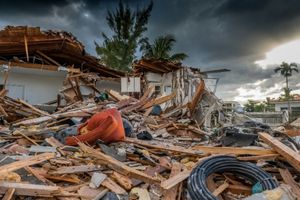
What would you do if a major natural disaster, such as a tornado or a hurricane, swept through your town and was coming straight for your house?
Or what would you do in the event of a home invasion where multiple armed burglars entered your house?
That’s why it’s crucial to have a secured room in your home that can keep you and your family hidden, sheltered, and safe during life-threatening emergencies.
This kind of room is commonly referred to as a panic room, and despite being very important, very few homes have any sort of a panic room in them at all.
In this article, we’ll cover why you need a panic room, the primary threats your panic room needs to protect you against, how to camouflage and secure your panic room, and how to stockpile your room so you and your family can outlast any disaster that comes your way.
Let’s get started.
What Is A Panic Room And Why Do You Need One?
A panic room, also known as a safe room, is simply a hidden and fortified room in your house that can provide you and your family a hiding place or shelter in the event of a home invasion, natural disaster, or any other kind of a critical threat that endangers your safety in your home.
Related: US Natural Disasters Map. What Calamity Do You Need To Prepare For?
Your panic room needs to be secured, hidden, reinforced, and well-stocked with supplies. It’s a room that you and your family can retreat to and hide in to stay safe during emergencies.
Your panic room can be located inside or outside of your home. Panic rooms range from fortified underground bunkers to hidden and reinforced closets or storage rooms.
The easiest way to build a panic room is to include it in the construction of a new home. This way, you can work with your home architect and builders so the room is incorporated into the construction of the home.
You can also better ensure that your panic room has all of the normal comforts that you are used to, such as a bathroom, sleeping area, storage space, and so on.
But many people don’t have this option to build an entirely new home with a panic room included. If this is the situation you’re in, the next best alternative would be to select an existing room in (or outside or underneath) your home to serve as your panic room.
Then, you’ll need to modify that room to make it panic room ready.
But first, let’s talk about the threats your panic room needs to protect you against.
Which Types of Threats Should Your Panic Room Be Ready For?
There are two primary threats that your panic room needs to protect you from: natural disasters and criminals.
Natural Disasters
A natural disaster is arguably the biggest reason to have a panic room. A severe natural disaster will result in destroyed or severely damaged homes, destroyed powerlines, streets that are completely shut down, and heavy debris that flies or floats at high speeds.
In the event of a major natural disaster of this magnitude (such as windstorms, tornadoes, fires, hurricanes, or flooding) staying in your home may not offer you adequate protection or security.
Furthermore, bugging out or trying to evade the disaster may not offer you sufficient protection either.
The only other option in this case is to bug into your panic room. A panic room with thick and insulated steel or concrete walls can provide you with safety from any of the aforementioned natural disasters.
When properly constructed or modified, a safe room can offer you and your family shelter from the natural and yet unpredictable storms raging outside.
If every home in the United States had a panic room, thousands of lives would be saved every year. You can ensure that you and your family are among those protected.
Criminals And Human Threats
Protection from criminals is the second major reason to invest in a panic room.
There are millions of burglaries that occur worldwide each year, and that’s also not to mention the threat of terrorist attacks or (depending on where you live in the world) enemy invasions.
A panic room can provide you with a safe place to hide during a home invasion, burglary, terrorist attack, or enemy invasion.
Choosing A Room For Your Panic Room
As mentioned prior, the easiest way to build a panic room is to include it in the construction of a new home. But if you’re not building a new home, you’ll have to select and modify an existing room in your home to serve as your panic room.
Most people will pick an existing closet, cellar, or storage space to serve as their panic room, while others will add onto their home by adding a space, such as adding a basement room or a room in the ceiling.
? How To Build A Cheap Bunker In Your Backyard
Regardless of the room that you choose, make sure you choose a room that has no windows. Your panic room must be fully concealed and have as few entry points as possible.
However, if the only existing room in the home that will work has windows, you can remedy this situation by installing bulletproof, high-ballistic windows that are designed to withstand forced entry.
It’s also critical for your panic room to be accessible to the frequented living spaces in the home.
Depending on the emergency, you may only have mere seconds to get everyone in your family into the panic room.
Last, but certainly not least, make sure that your panic room is large enough to house your entire family along with at least three day’s worth of supplies.
Securing Your Panic Room
Once you’ve picked a room in your home to serve as the panic room, the next step is to secure the room.
The walls of the panic room must be built out of materials capable of withstanding forced entry and extreme weather conditions. The idea is that even if the outside of your home is severely damaged, such as in the case of a natural disaster, your panic room will still be standing.
Concrete is arguably the best material to use as the walls for your panic room. But if you cannot modify your designated panic room, Kevlar, steel or fiberglass would be the next best option. For example, you can have steel, fiberglass, or Kevlar sheets professionally installed over your existing walls and ceiling of your panic room.
Related: 7 Prepping Items FEMA Will Confiscate When SHTF
There should be minimal entry points leading into your panic room, and any entry points leading in must be as reinforced as possible. The door that directly leads into your panic room is arguably the most critical component of your panic room to reinforce to deny forced entry.
Replace your existing door with a steel door, and make sure that your door knobs and hinges are all replaced with heavy duty knobs and hinges. There are security knobs and hinges that are built specifically for this purpose.
Then, make sure that your door is secure to the surrounding walls. The idea with your door is that it cannot be beaten down by home invaders armed with tools such as hammers, mallets, axes, or rifle stocks.
Then, you’ll need to camouflage your door to keep your panic room hidden. Examples of what you can do include hiding your safe room under the floor and the door under a rug, covering the door with a painting or piece of artwork, or disguising your door so it initially appears to just be a part of the wall.
Last but not least, ensure that your panic room has a suitable air filtration system. You must ensure that your panic room receives a reliable supply of high quality air.
Look for professionally-made air filtration systems that are designed specifically for panic and emergency rooms.
Make sure that your air filtration system includes NBC (nuclear, biological, chemical) protection. Investing in an air filtration system that meets these qualities will cost you a bit of money, but it will be well worth it.
Stockpiling Your Panic Room
Keep in mind, your safe room doesn’t just have to be a room that you and your family retreat to during an emergency.
It can also double as a room in which you store your valuables, such as firearms, ammunition, money, jewelry, heirlooms, and other valuables.
You should also store supplies in your panic room so you and your family can live there for a short period if you need to.
Food And Water
Plan to stockpile at least a three day’s supply of food and water in your panic room. For water, you’ll need a gallon of water per person per day.
Simply add up the total members of your family, and then multiply by three to have enough water set aside for three days.
Make sure to rotate your water out once every three months.
For food, plan on storing non-perishable items such as MREs, freeze dried fruits and vegetables, canned food or food bars.
Communications Equipment
Communication equipment is vital to store in your panic room so you can stay in contact with the outside world. Have a two way radio and a landline phone installed in your panic room at the bare minimum.
If the grid is down or in the event of an EMP, here you can find the only way to safely communicate off grid in a crisis.
High end panic rooms will also come with surveillance equipment installed showing you every other room of the house as well as around the property.
Weapons
As mentioned above, your panic room can double as a room where you store your firearms. Regardless, make sure that you have defensive weapons in your panic room just in case home intruders break through.
Besides defensive firearms, you can also keep defensive tools such as a baseball bat, taser, and pepper spray in your room as well.
Extra Equipment
Extra equipment to consider storing in your panic room includes:
- Blankets and Sleeping Bags
- Clothing
- First Aid Kit
- Flashlight (with extra batteries)
- Money
- Sanitation and Personal Hygiene Items
Hopefully this article has given you a good idea of what a panic room is and how you can build one in your home.
Be sure to continue your research, and start thinking about which room in your home could potentially serve as your panic room and how you can start modifying it to ensure it’s concealable and secured.
You may also like:
Food-Stretching Tips From The Great Depression
10 Medical Supplies You Need To Stockpile In Your Panic Room (Video)
DIY Home Remedy For Bronchitis
25 Things We Did as Kids That Would Get Someone Arrested Today
Classified FEMA Report Confirms Preppers’ Worst Fears


